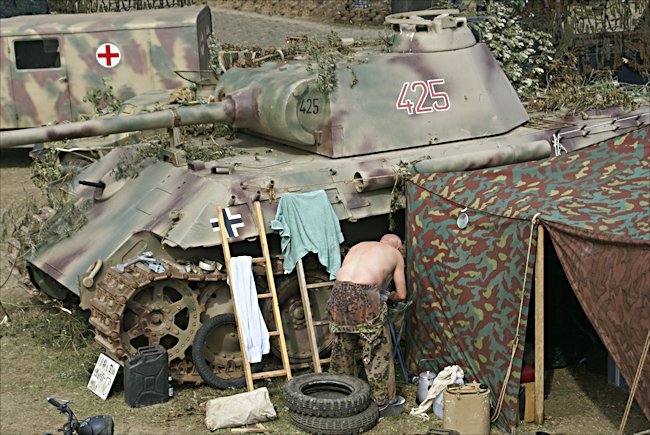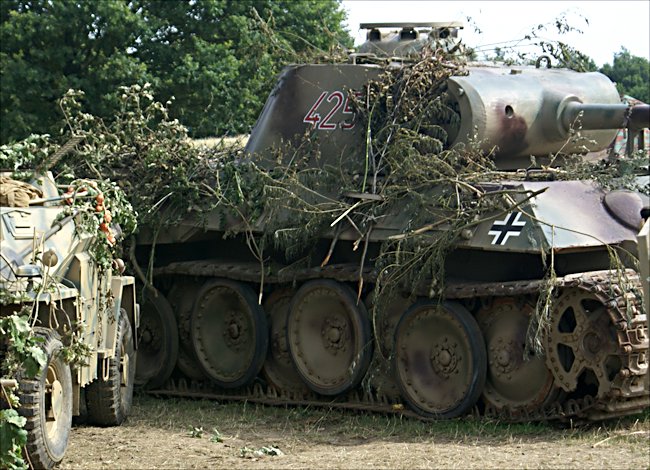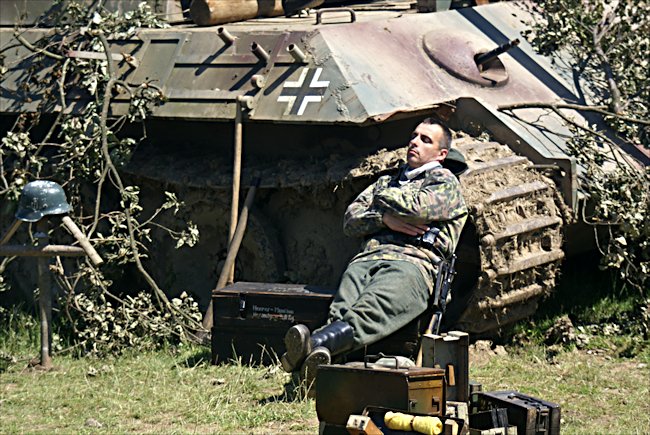The Panther Tank Ausf. A
This German Panther Tank Ausf. A Number 425 was owned by the Rex and Rod Cadman Collection in England and is often seen at military vehicle events in the summer in Britain like the annual 'War and Peace' Show in Folkestone. It has now been sold to the new Australian Armour and Combat Museum, Cairns, Queensland, Australia. It is being restored by Bruce Crompton's Company before being shipped to Australia.

German WW2 Panther Tank Number 425. Notice the use of sloping armour on the sides as well as the front.
The hull and turret were manufactured in the Hermann Goring Steel Works in Linz, Austria, but the final assembler is unknown due to the loss of its original chassis number. It was knocked out in Normandy in 1944. The original German chassis number was obliterated when it was given a new French AMX chassis number, following its post-war refurbishment by the French AMX factory. The French Army operated German Panther Tanks after the end of WW2 until as late as 1955 for testing purposes.
This tank served with either the French 501-503 RCC army regiment or the 6e Cuir cavalry regiment before spending some time on a French target range. It was rescued and taken to the French Tank Museum in Saumur along with eleven other Panther tanks. It was then sold to Rex and Rod Cadman who added it to their collection In England. In 2015 it was sold it to the Australian Armour and Combat Museum.
How to kill 9 Panther tanks
By the end of D-Day the Allies had breached Hitler’s Atlantic wall and had begun their advance inland. British and Canadian forces head south towards their next objective, the strategically important city of Caen.
But scarcely had the M4 Sherman tanks of the 2nd Canadian Armoured Brigade got off the beaches than they encountered another deadly unexpected peril. The picturesque Normandy landscape. It is a maze of narrow fields with 5 meter high hedgerows and sunken lanes that can easily conceal a German 88mm Anti-tank gun, tank destroyer or tank waiting in ambush.
Driving a tank across the fields or down the narrow lanes was dangerous. In Normandy most of the fighting was at close range making surprise absolutely vital. Tank commander Canadian Captain S.V. Radley-Walters of the Sherbrook Fusiliers Regiment recalled, "The first idea you get is for Christ sake get out into the field and start moving."

German WW2 Panther Tank Ausf. A Number 425. It was a bitch of a job to change a track wheel.
British Sherman tank crew member Lance Corporal Ken Tout, 1st Northamptonshire Yeomanry, when talking about Normandy said, "Suddenly you are up against a Normandy hedge. It is on a two foot high bank and can be 14 feet high in places. You go crashing through it and you go down into a sunken road four feet deep. You then have to go across the road and up through another Normandy hedge."
When commenting on the Normandy hedges his M4 Sherman had to negotiate tank wireless operator Canadian Trooper Phil Lawrence, Sherbrooke Fusiliers Regiment said, "They were very difficult to get into and very difficult to get out. You can get hung up in the hedge and you are totally vulnerable. If you did not have a plan you would get nailed because the enemy always had a plan."
What Lawrence was talking about was the fact that as the Sherman started to climb up the opposite hedge bank and through into the next field the under belly of the tank was exposed briefly. If there were Germans dug in and waiting they had an easy thinly armoured target to aim at. After a number of tanks were destroyed doing this the M4 Sherman crews worked closely with the infantry or got out of their tank themselves to check the next field for signs of the enemy before entering it

The side armour of a German WW2 Panther Tank was a lot weaker than the front. It only had 50mm or armour plate.
D-Day +1: despite the difficult terrain the tanks of 2nd Canadian Armoured Brigade make steady progress towards Caen. As the battle moves into its second day they encounter a column of nine German Panther tanks move across their front from right to left exposing the side of their tanks.
The Panzer V Panther tank was probably one of the best tanks of World War Two. Its wide tracks and powerful engine gave it good cross country mobility. It had a long barreled high velocity 75mm cannon which was deadly to all Allied tanks even at long range. It was protected by 80mm of sloping frontal armour which was virtually indestructible to most Allied tank guns.
These advantages did not help this column of 9 Panthers. They were side on to the advancing Canadian Sherman tanks. The Panther only had 50mm of armour on its side. The Sherman’s Short barreled 75mm gun could penetrate that thickness of armour if they were close enough.

The wide tracks on the German WW2 Panther Tank helped with cross country off road driving
For Phil Lawrence, and the other tank crews of the Sherbrooke Fusiliers Regiment, this was going to be their first encounter with enemy tanks. Lawrence recalls, "We heard from the infantry that there were some Panther tanks coming. The tanks were fairly close to, about 900 yards, and meanwhile I am trying to wake up my gunner. The Captain got us all lined up. Each of us was given a target, and I am kicking the gunner in the legs trying to get some life into him. By this time the order to fire had been given, and my gunner is fast asleep. It is very scary. The crew commander was batting his head with his hands to wake him up. He said to the gunner, ‘you useless son of a bitch. You are now the co-driver. Get in there and try not to get in anyone’s way’. Finally he traversed around and managed to fire. We hit the panther in the side. "
"It was not so much as a battle as an ambush. Those poor sods did not know what hit them. One moment they are riding along one behind the other and the next moment, you know, everything is on fire. They fought their Panther tanks in a way we thought was kind a stupid. We could knock them off easily. All nine Panthers were knocked out just like that. I thought wow this is a breeze. I like this. We would be on our way to Berlin next week. Boy I was wrong."
In error the Germans turned their turrets to face the Shermans rather than turning their tank so the strong frontal armour faced the Canadians. They paid the price for this poor tactical decision. This did not happen very often. The M4 Sherman tanks were very lucky.
Where can I find other preserved Panther Tanks?
- Panther Ausf. A - Wheatcroft Collection, England
- Panther Ausf. A - Befehlspanzer Munster Germany (running condition)
- Panther Ausf. A - (n° 224) Auto + Technik Museum, Sinsheim, Germany
- Panther Ausf. A - (n° 243) Auto + Technik Museum, Sinsheim, Germany
- Panther Ausf. A - (n° 413) Private Collection, Germany
- Panther Ausf. A - (n° 256) Saumur Tank Museum France
- Panther Ausf. A - (n° 211) Saumur Tank Museum France (running condition)
- Panther Ausf. A - Omaha Overlord Museum, Colleville-sur-Mer, France
- Panther Ausf. A - 501/503e RCC Mourmelon-le-Grand France
- Panther Ausf. A - (n° 201) Royal Jordanian Tank Museum, Jordan
- Panther Ausf. A - Australian Armour and Artillery Museum, Cairns, Queensland.
- Panther Ausf. A - National Armor and Cavalry Museum, Fort Benning, GA,USA
- Panther Ausf. A - U.S. Army Ordnance Museum, Fort Lee, VA, USA
- Panther Ausf. A - The Collings Foundation, Stow, MA, USA (running condition)
- Panther Ausf. A - Canadian War Museum (CWM) in Ottawa Canada
- Panther Ausf. A or D Panzermuseum, Thun, Switzerland
- Panther Ausf. D - Breda Netherlands
- Panther Ausf. G - Bovington Tank Museum England (British Built)
- Panther Ausf. G - Wehrtechnische Dienststelle, Trier, Germany (British Built)
- Panther Ausf. G - Privately owned now confiscated by police, Germany (British Built)
- Panther Ausf. G - National War and Resistance Museum, Overloon Netherlands
- Panther Ausf. G - Houffalize Belgium
- Panther Ausf. G - Grandmenil Belgium – engine, gearbox and transmission are present
- Panther Ausf. G - Celles Belgium
- Panther Ausf. G - (n° 332) Saumur Tank Museum France
- Panther Ausf. G - Kubinka Tank Museum Russia (running condition)
- Panther Ausf. G - U.S. Army Ordnance Museum, Fort Lee, VA, USA
- Panther Ausf. G - 2x National Armor and Cavalry Museum, Fort Benning, GA, USA
- Source - Pierre-Oliver Buan - http://the.shadock.free.fr/Surviving_Panzers.html
WW2 tank books

